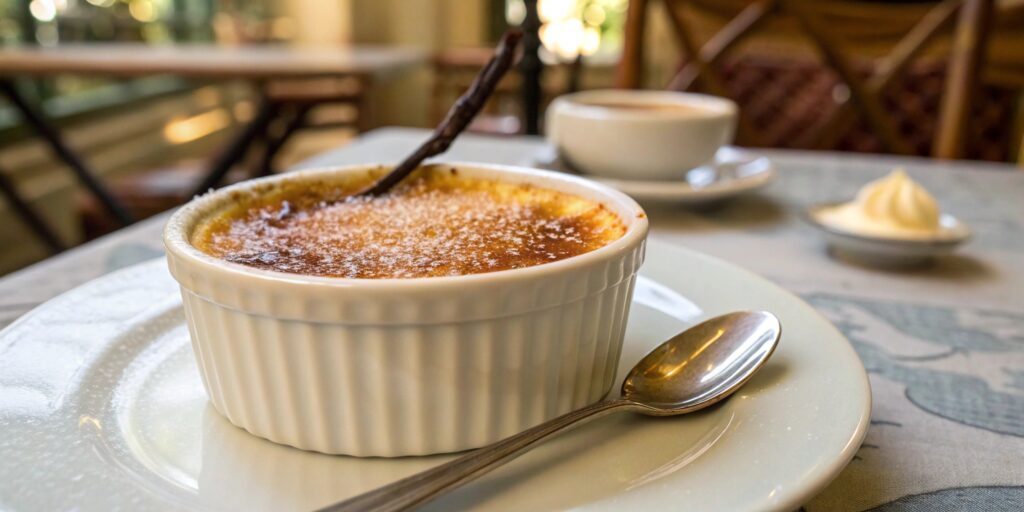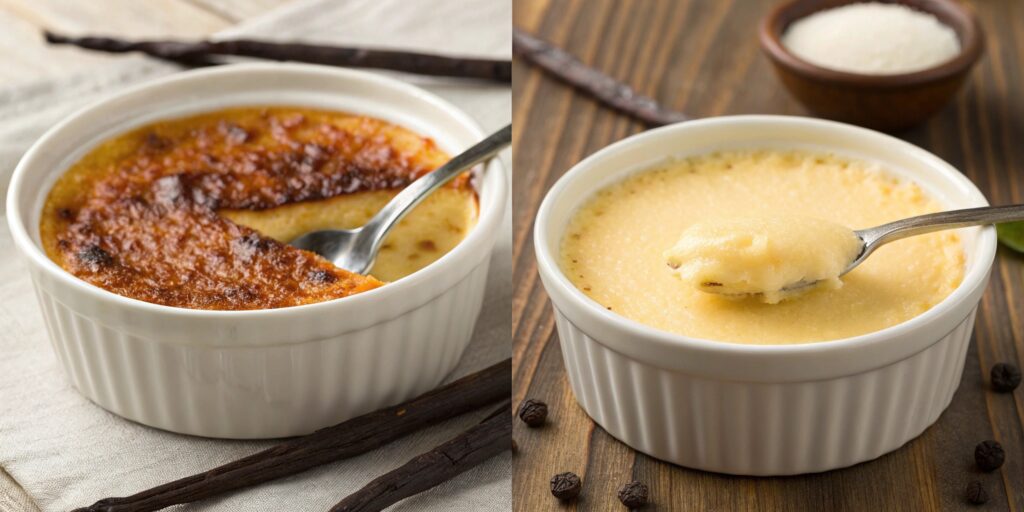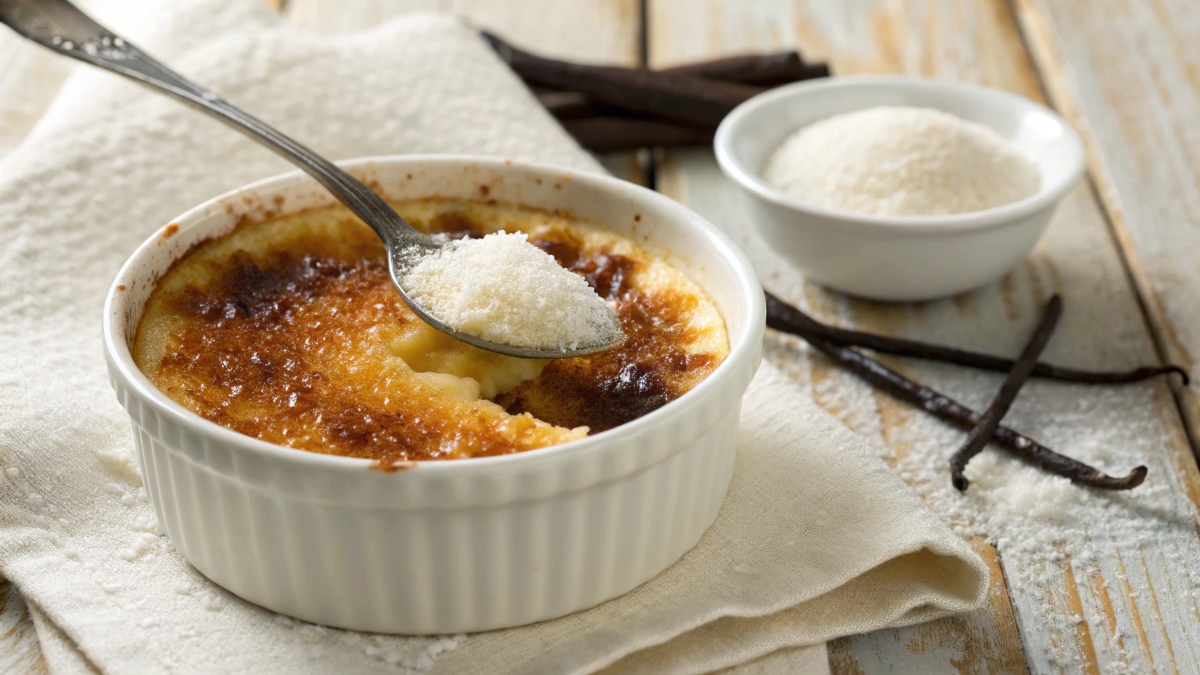Crème brûlée is a timeless French dessert, renowned for its silky smooth custard base and crisp, caramelized sugar topping. But what exactly makes this dessert truly exceptional? Whether you are a beginner or an experienced home baker, mastering the secrets behind crème brûlée will undoubtedly elevate your dessert skills to the next level! 🍮🔥
Table of Contents
- The History of Crème Brûlée
- What Makes Crème Brûlée So Special?
- The Secret Ingredient for Perfect Crème Brûlée
- Why Is the Caramelized Sugar Top Important?
- How Temperature Affects the Perfect Texture
The History of Crème Brûlée

Crème brûlée, which directly translates to “burnt cream,” boasts a long and fascinating history that dates back to 17th-century France. Over time, this dessert gained prominence in fine dining due to its delicate custard base and signature caramelized sugar layer. Although many believe it was originally crafted in the kitchens of the French court, both Spain and England have introduced their own similar variations.
What Makes Crème Brûlée So Special?
The irresistible contrast between the rich, creamy custard and the crisp, caramelized topping is what makes crème brûlée truly stand out. Although the custard itself is made using simple ingredients—egg yolks, sugar, heavy cream, and vanilla—achieving the ideal consistency requires both precision and skill.
The Secret Ingredient for Perfect Crème Brûlée
Ultimately, the key to crafting a flawless crème brûlée lies in using high-quality ingredients combined with a precise technique. Below are the most crucial factors to consider:
The Role of Egg Yolks in Custard
Egg yolks play a fundamental role in achieving the silky texture of the custard. Therefore, using fresh, high-quality egg yolks will result in a rich and creamy consistency.
Choosing the Right Cream
Undoubtedly, heavy cream is essential for ensuring a smooth and velvety custard. Avoid low-fat alternatives, as they tend to create a grainy texture.
Balancing Sweetness with Vanilla
In order to enhance the flavor without overwhelming the dessert, it is best to use either vanilla beans or high-quality vanilla extract. For a gourmet touch, scraping a real vanilla bean into the custard will take the taste to the next level.
Why Is the Caramelized Sugar Top Important?
Without a doubt, the crunchy caramelized sugar layer is the signature feature of crème brûlée. A properly caramelized sugar topping creates the satisfying “crack” when gently tapped with a spoon.
Choosing the Right Sugar
For a flawless caramelization, it is advisable to use superfine sugar. This type of sugar melts evenly, preventing any unwanted burning.
The Science Behind Torch vs. Oven Broiling
Many chefs prefer using a kitchen torch to caramelize the sugar for a consistent finish. However, if you do not have one, the **oven broiler** serves as a suitable alternative. Nevertheless, it requires careful monitoring to prevent overcooking or burning.
How Temperature Affects the Perfect Texture
One of the most important secrets to crème brûlée success is temperature control. Baking the custard at a low temperature, typically around 300°F (150°C), in a water bath (bain-marie) guarantees a smooth and evenly cooked texture.
Step-by-Step Guide to Making Crème Brûlée
Now that we fully understand the science behind crème brûlée, let’s dive into the step-by-step process of making this delectable dessert. By carefully following these instructions, you can achieve the perfect texture and flavor every time!
Step 1: Preparing the Custard Base
- Ingredients: 2 cups heavy cream, 5 egg yolks, ½ cup sugar, 1 vanilla bean (or 1 tsp vanilla extract)
- First, preheat your oven to 300°F (150°C).
- Meanwhile, in a saucepan, heat the heavy cream and vanilla over medium heat until warm, making sure it does not reach a boil.
- At the same time, in a separate bowl, whisk together the egg yolks and sugar until the mixture becomes pale and creamy.
- Gradually pour the warm cream into the egg mixture while whisking continuously to prevent the eggs from scrambling.
Step 2: The Best Baking Method for Crème Brûlée
In order to achieve the perfect texture, the custard must be baked gently. The best way to accomplish this is by using a bain-marie (water bath).
- To begin, pour the custard mixture evenly into ramekins and carefully place them in a deep baking dish.
- Then, fill the baking dish with hot water until it reaches halfway up the sides of the ramekins, ensuring an even, slow bake.
- Next, bake for approximately 30-40 minutes, or until the custard is set but still slightly jiggly in the center.
- After baking, remove the ramekins from the oven and allow them to cool before refrigerating for at least 4 hours.
Step 3: Achieving the Perfect Caramelized Sugar Topping
Once the custard has fully chilled, it is time to create the classic caramelized sugar topping that gives crème brûlée its signature crunch.
Using a Kitchen Torch
- First, evenly sprinkle a thin layer of superfine sugar over each custard.
- Then, using a kitchen torch, gently caramelize the sugar by moving the flame in a circular motion until it turns a golden brown color.
Using an Oven Broiler
- If you don’t have a torch, don’t worry! Simply preheat your oven’s broiler.
- Next, place the ramekins under the broiler for about 1-2 minutes. However, be sure to watch closely to prevent the sugar from burning.
Common Crème Brûlée Mistakes & How to Fix Them
Even experienced bakers can encounter issues! Below are some common mistakes and practical solutions to ensure your crème brûlée turns out flawless.
Why Did My Custard Turn Grainy?
If your custard has a grainy texture, it was most likely overcooked or baked at too high a temperature. To prevent this, always use a water bath and double-check that your oven temperature is accurate.
How to Fix a Runny Crème Brûlée
If your custard turns out too soft or runny, it may not have baked long enough. In this case, return it to the oven for a few additional minutes. Additionally, allowing it to chill longer in the refrigerator can help it set properly.
Can You Make Crème Brûlée Without a Ramekin?
Absolutely! If you don’t have ramekins, you can use ceramic bowls, glass jars, or even oven-safe teacups as substitutes.
How to Customize Your Secret Crème Brûlée
Once you’ve mastered the classic version, why not get creative? Here are some fun ways to personalize your crème brûlée for unique flavors.
Chocolate Crème Brûlée
For a rich, indulgent twist, add 2 ounces of melted dark chocolate to the custard base before baking.
Coffee & Espresso Infused Crème Brûlée
Replace half of the heavy cream with brewed espresso to give your crème brûlée a bold coffee kick.
Berry-Infused Crème Brûlée
Add fresh raspberries or a spoonful of fruit puree to each ramekin before pouring in the custard.
Dairy-Free and Vegan Alternatives
Need a dairy-free option? Try these substitutes for a plant-based version.
Using Coconut Milk for a Dairy-Free Option
Swap heavy cream for full-fat coconut milk to maintain creaminess while keeping it lactose-free.
How to Replace Egg Yolks in Vegan Crème Brûlée
Use cornstarch or agar-agar as a thickener instead of eggs. This will create a silky custard without dairy.
How Long Does Crème Brûlée Last?
Crème brûlée is best enjoyed fresh, but here’s how you can store it properly:
- Refrigerate: Keep the baked custard (without the sugar topping) covered for up to 3 days.
- Freezing: While not recommended, you can freeze crème brûlée for up to 1 month. Thaw overnight in the fridge before serving.
- Caramelizing Later: Caramelize the sugar topping just before serving to maintain crispness.
Can You Make Crème Brûlée in Advance?
Yes! You can prepare the custard a day ahead and refrigerate. Just add the caramelized sugar right before serving for the best texture.
Crème Brûlée vs. Custard: What’s the Difference?

People often wonder how crème brûlée differs from other custard-based desserts. Here’s a quick comparison.
Crème Brûlée vs. Flan
Unlike crème brûlée, flan has a soft caramel sauce instead of a hardened sugar top.
Crème Brûlée vs. Pudding
Pudding is thickened with cornstarch rather than eggs, making it a different consistency from crème brûlée.
Frequently Asked Questions About Secret Crème Brûlée
Can You Make Crème Brûlée Without Heavy Cream?
Yes! Try using half-and-half or coconut milk as an alternative.
Why Does My Sugar Topping Burn Too Quickly?
If your sugar burns too fast, move your torch further away and caramelize slowly.
Can I Use White Sugar Instead of Brown Sugar?
Yes! Superfine white sugar works best for an even caramelization.
What’s the Best Way to Serve Crème Brûlée?
Serve chilled with fresh berries or a light dusting of powdered sugar for an elegant presentation.
How Can I Make a Lighter Version?
Use a mix of heavy cream and whole milk to reduce the richness while keeping the creamy texture.
Final Thoughts: The Secret to the Perfect Crème Brûlée
Mastering crème brûlée requires patience, high-quality ingredients, and proper techniques. Whether you prefer the classic vanilla version or enjoy experimenting with flavors, this dessert is sure to impress. Ready to try it? Check out our best crème brûlée recipe and start baking today! 🍮🔥

